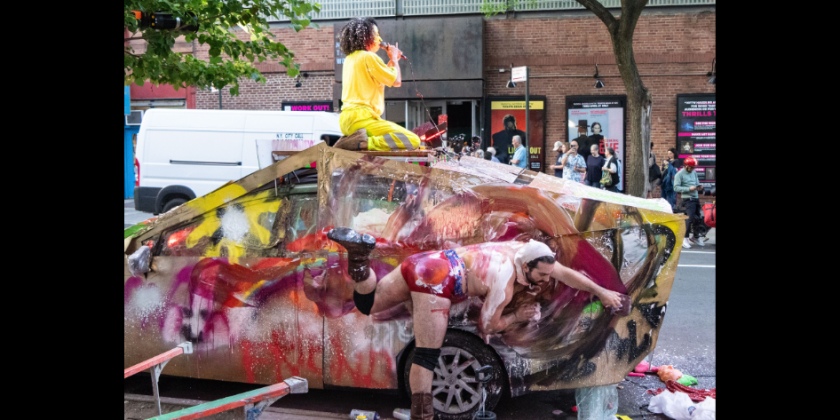IMPRESSIONS: Luca Veggetti Reimagines Jerome Robbins' “Watermill” at BAM Fisher

October 27, 2018
Original choreography: Jerome Robbins
Re-imagined by: Luca Veggetti
Music: Teiji Ito.
Music Direction: Steve Gorn
Musicians: Steve Gorn, Tavia Ito, Mara Purl, Ralph Samuelson, Yukio Tsuji
Featuring: Joaquin De Luz with Aleksandra Gologorskaya, Quaba Ernest, Leo Hishikawa, Anthonio Brady, and Mayra Donis, Noelle Hauptmann-Anderson, Lucy Quattlebaum, Kiersten Rist, Kathryn Taylor, Bailey Vaughn, Kirstin Zahradnick, Ruben Castillo-Gomez, Nathan Crewe-Kluge, Richard Figueroa, Erik Osterkil, Joshua Noel, Kar’mel Small, Cong Zhang, and Mengnan Zhao
When Jerome Robbins first presented the contemplative Watermill in 1972, many were disappointed by the departure from the famed choreographer’s typically zippy, entertaining ballets. In contrast, Watermill perfectly suits Luca Veggetti, the Italian choreographer known for his intense, suspenseful work. While New York City Ballet has occasionally revisited the work, Veggetti’s reimagining as part of BAM’s Next Wave Festival offers a fresh, approachable perspective.
Named for the sleepy Long Island resort town in which it was conceived, Watermill places the infinite circularity of nature’s cycles — the moon, the seasons — adjacent to the linear structure of a human lifetime. A lone man, perhaps a representation of Robbins himself, reflects on his life with longing and regret. In the original, legendary NYCB principal Edward Villella played this role. In Veggetti’s version, it is a part well suited to Joaquin De Luz, who retired from NYCB just two weeks prior earlier.

Though the protagonist’s movement is limited, only a mature dancer could be taken seriously in this role, which requires Noh-inspired stillness and introspection. De Luz reveals his vulnerability early when he deliberately strips and stands before us mostly naked. He lunges with wide, rounded arms, as though he is Atlas, burdened by the weight of the entire world.
Though the choreography is all Robbins’, Veggetti takes liberties in staging. Perhaps the most noticeable difference is the audience’s proximity — in the close-quartered Fisher Theater, we surround the piece on three sides, lending intimacy to the experience.
Indeed, upon entering, we are greeted by three lofty structures composed of bundled reeds. They’re positioned in a triangle at the center, a gleaming sliver of a moon projected on the scrim behind. It seems as though we’ve stumbled upon a clearing while walking at night through marshy woods. The musicians — on Japanese bamboo flute, gongs, bells, drums, and dulcimer — are stationed upstage left, high above the stage where they play Teigi Ito’s trance-like score. The dim lighting barely exposes the outline of twenty dancers, students from the State University of New York at Purchase Conservatory of Dance, seated on a bench at the back. Just like De Luz’s slow, significant movement, the space feels laden with intensity and potential.

As the protagonist looks back on his life, flashes of memory strike him. A younger version of himself (Quaba Ernest) happens upon a reclining beauty, the lovely Aleksandra Gologorskaya. Alone, she appears confident and a bit coy, but when Ernest engages her in a suspenseful, erotic duet, she is submissive, allowing him to manipulate and contort her willowy limbs.
While Robbins used seasoned NYCB dancers, Veggetti employs students as the corps de ballet. These young dancers take on the intense movement with focus and sophistication, yet the juxtaposition of their youth against De Luz’s maturity perpetuates the theme.
Leo Hishikawa acts as another representative of a young De Luz. In a rattling scene, he is attacked by a terrifying monster wearing a headpiece made of straw. He thrashes on the ground as the demon and several masked figures surround him, perhaps enacting a nightmarish childhood experience.

In the most stunning moment of the entire piece, De Luz lunges and stretches his arms toward opposite sides of the space, two reeds extending the length of his arms by maybe 10 feet. It’s as if he’s been transported out of his mortality and into some supernatural figure. He pauses with the reeds extended toward the ceiling and gazes up at them with childlike wonder.
Stagehands on the catwalk sprinkle white flakes onto the stage below — De Luz is entering the winter of his life. In a striking but obvious closing image, he is confronted with a visual representation of his own morality, in the form of a hunched, caped figure with a cane. The lights dim as the two face one another in solemn understanding.
Veggetti’s reimagining of “Watermill” perfectly captures the perplexing nature of time — while individual moments can seem slow, the hour is over before we know it.
The Dance Enthusiast Shares IMPRESSIONS/ our brand of review and Creates Conversation.
For more IMPRESSIONS, click here.
Share your #AudienceReview of performances for a chance to win a prize.














